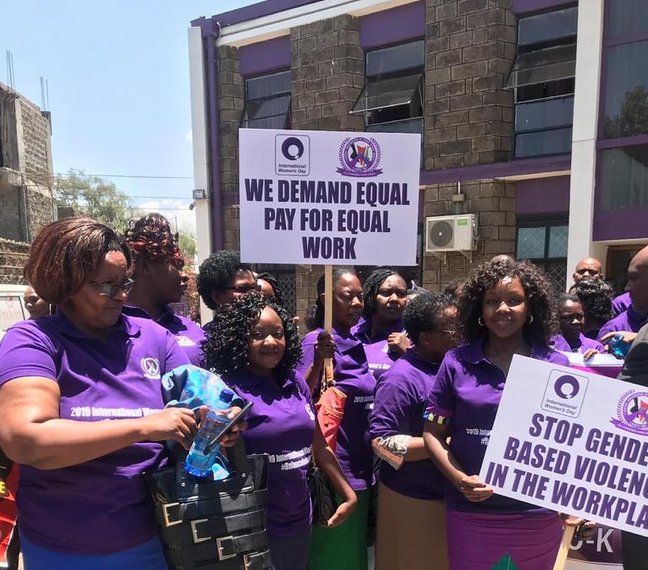9 May, 2019The gender pay gap is one of the greatest illustrations of gender inequality in the world of work. Unions have an important role in ending the disparity between men’s and women’s wages.
The gender pay gap stands at 18.8 per cent across the world. It is not simply due to factors like experience, education, productivity or performance, that would usually determine wages in the labour market.
Instead, occupational segregation and the polarization by gender of industries and economic sectors stand out as key reasons for the gender pay gap, according to two new studies by the ILO on global wage and gender equality.
Women continue to be under-represented in traditionally male-occupied industries which pay more. The most in-demand and highest-paying jobs are found in STEM sectors (Sciences, Technology, engineering and mathematics), where women represent a fraction of the workforce.
Work performed by women is frequently undervalued and underpaid, either because it mirrors work that has traditionally been carried out by women in the home, or simply because women are paid less for work of equal value.
In occupations which have gradually become dominated by women, such as primary school teaching, salaries have relatively declined for both women and men. Once a profession is defined as predominantly female, it is undervalued.
The 2019 ILO report “A quantum leap for gender equality : for a better future of work for all”, shows that women in Europe can expect to earn 14.7 per cent less in a business with a predominantly female workforce compared to working in a similar enterprise with a male dominated workforce.
The report also shows that many women in the digital economy earn less than men. Crowdwork (where work is outsourced through a digital platform in an open call to a geographically dispersed crowd) risks becoming just another trap for women, offering low paid, intermittent work.
Motherhood also contributes to the gender pay gap. Mothers earn less than women without children. This may be related to labour market interruptions or reduction in working time, but also to employment in more family-friendly jobs that are lower paying, or stereotypical hiring and promotion decisions at enterprise level that penalize the careers of mothers.
What can unions do to close the gender pay gap?
According to ILO ACTRAV ‘s report on the role of trade unions in closing the gender pay gap, the more centralized the collective bargaining process, the smaller the pay gap. Many women work in less unionized sectors and are therefore unlikely to be covered by collective bargaining agreements.
In high-income countries, higher trade union density is associated with a lower gender pay gap.
However, equal pay for work of equal value is not often part of wage negotiations, and when it is, it is mostly through measures to address overall wage inequality, rather than through gender-specific measures.
Jenny Holdcroft, IndustriALL assistant general secretary“Collective bargaining is proven to increase wages and close the gender wage gap. But we need more women at the top of unions and at the negotiating table if we are going to win equal wages. Women’s increased participation and representation is necessary to ensure that men and women benefit equally from collective bargainaing gains.”
ACTRAV and the ILO have developed recommendations for union action to close the gender pay gap:
Address gender discrimination
Unions must challenge gender stereotypes and social norms that limit women access to labour markets and quality jobs, and contribute to gender segregation. Bargaining should include measures tackling obstacles for the women to access employment, such as policies on work/life balance for men and women; equal opportunity for training and career development; improving paid parental leave; enhancing access to child care and tackling sexual harassment.
Demand specific gender equality measures
Unions should make specific demands to close the gender pay gap including greater transparency of wages and salary scales; higher wages for female-dominated jobs; gender-neutral job evaluations to avoid gender biases in job classification and pay systems; and the reevaluation of female-dominated occupations or sectors.
Promote inclusive wage-setting
Trade unions and collective wage-setting contribute to reducing overall wage inequality. Unions must consider how to extend minimum wages and collective bargaining to cover female-dominated sectors, as well as informal or precarious workers who are mainly women. Campaigns to raise the minimum wage to a living wage for all workers help to increase women’s pay.
Protect women in supply chains
The concentration of women at the very end of global supply chains, where regulations are likely to be weakest and competitive pressures strongest, also contributes to the gender pay gap.
Global framework agreements with multinational companies can play an important role in improving working conditions. For example, IndustriALL’s programmes with garment workers in Turkey as part of global agreements with Inditex, H&M and ASOS have helped to raise awareness of gender equality issues in the workplace. The ACT process will also play a key role in raising women’s salaries in the supply chain.
Empower women
Unions should ensure women’s representation in decision-making bodies and at the negotiating table to get a better deal for women in the workplace. Women’s representation in union leadership and collective bargaining teams have a significant impact on the extent to which negotiated outcomes benefit women workers.
